By Soh Rui Yong
[Editor’s note: Soh Rui Yong ran the second-fastest marathon time by a Singaporean in history at the California International Marathon to qualify for the Southeast Asian Games next year. This personal account of the race was first published on the author’s blog and is re-published with permission with minor editions for style and language.]
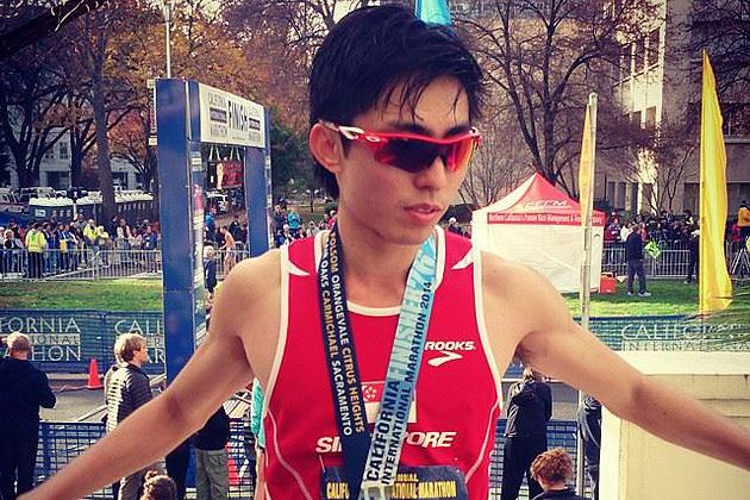
Soh Rui Yong after the California International Marathon, where he clocked 2 hours 26 minutes 1 second to become the second-fastest Singapore marathoner ever and qualify for the 2015 Southeast Asian Games on home soil. (Photo courtesy of Soh Rui Yong)
2 hours, 26 minutes, 1 second.
I’m still surprised at how my first marathon went.
Surprised at how much harder actually finding your bottle during the race is than it looks. (I missed four out of my six personal bottles.)
Surprised at getting to 30km, 32km, then 34km, with minimal fatigue, feeling absolutely incredible.
Surprised at passing about 20 people in the last 10 kilometres, when I started my finishing surge.
Surprised that the last 10 kilometres were clocked in 33 minutes 29 seconds, which, just three years ago, would have been a personal best for the distance.
Surprised with my finishing time – more than 2 minutes 30 seconds faster than my pre-race target and the Southeast Asian (SEA) Games gold medal mark of 2:28:36.
Most of all, I’m surprised at how easy the race felt for me and how enjoyable, exciting, and natural it all came to me. Despite the warnings from my coach, my teammates, my friends, and input from others who had done the marathon previously, at no point in the race did I feel tired and sorry for myself. My breathing was relaxed the whole way, I could sustain a conversation at any point in the race and, apart from a slight upper thigh cramp with two kilometers to go, I felt pretty amazing the whole way.
People often describe the marathon as a learning journey, something which you should not attack like the 5000m on the track, but something you learn about gradually with time and experience. I came into the California International Marathon (CIM) confident, but mentally prepared that months of training could all so easily go to waste with one wrong move, one wrong decision, or simply a stroke of bad luck.
I was well aware that a painful first marathon was a very real possibility, but did not spend much time going down that path of speculation. I focused on the positives – I had five months of good marathon-specific training since setting the Singapore 10,000m record in June, I had run up to 23 miles (37km) in training feeling great, I had consistently run 140–160km a week during this training cycle, and, mostly importantly, I had gotten through everything healthy and fresh. No injuries were suffered, and I could still float through faster-paced 400m intervals on the track for when a change of gear was required. There was very little, if anything, I could have done better in the preparation for my first marathon.
I slept well the day before the marathon. No nerves. Perhaps partly due to the few sips of beer I had at dinner (spaghetti and meatballs, one slice of veggie pizza, one slice of cheese pizza), but more likely due to my new ability to not worry about things I cannot control. Just try and get a good night’s sleep, then get up and do my best.
So, the night before, I went to bed at 9pm, got up at midnight to use the bathroom, lay down and took a while to fall back to sleep, then woke up to the sound of my alarm at 3.30am feeling well rested. Six hours of sleep is perhaps not ideal on a regular basis, but because I had been consistently getting eight to nine hours of sleep a day during the weeks leading up to CIM, I felt confident that one night of less sleep was not going to have a negative impact on my performance.
For breakfast, I had four slices of peanut butter-and-jelly sandwiches, two cups of Gatorade, and a banana. Brett Ely and I then assembled in the lobby of the race hotel, where we were soon escorted to a shuttle that took us on an hour’s drive from Sacramento to Folsom. Somewhere along the trip, I got a little nervous thinking, “Geez, we have to run all the way back?”
Upon getting to the race venue, I tagged along with my very experienced and smart teammate Brett to get through our warm-up routine, use the bathroom, and take care of other pre-race activities.
Finishing my strides and getting to the start line, I felt relaxed, tuned up, and ready to go. We were flagged off to the blare of the air horn at 7am sharp.
I bolted into the front of the pack for a good 10 seconds, so used to starting fast at track or half marathon races, then dialed it back.
“Relax,” I told myself. Very long way to go still.
I quickly found a group of runners that were targeting a 5:40 minutes per mile pace (2:28:30 marathon pace) and settled into the group. We had about eight men and two women in the group, making it sizeable — good for blocking the wind — but tricky. A big group introduces many external factors, such as heel clipping, bumping of elbows, and pace fluctuations. Though we were happy to have company as we worked together a common goal, it was also important to give each other enough room and to stay out of trouble.
For most of my race, the plan was to stay absolutely relaxed from the start to 20 miles (32km).
With 2:28 pace being something the top women are able to run, we had three of them in our pack, including a friend of mine, the incredibly tough Renee Baillie of Bend, Oregon. (Renee has a personal best of 2:27:17 from the 2012 Chicago Marathon.)
This was both a blessing and a curse. Though it was great that I got to click off miles with Renee, comfortably running with a familiar face, not all the men in our pack were evidently happy to run behind a lady. So, whenever the ladies happened to move up, there was always shuffling within the pack as some men tried to pick up the pace. A few miles in though, the restless separated from our pack, allowing us to settle into a more even pace.
5:36, 5:41, 5:36, went the first three miles. I felt like I was jogging. I had never run more than two repetitions of five miles at marathon pace in training but, after a three-week taper, I felt ready to do something my body had never handled before.
I missed my bottle at the ‘elite’ hydration table at mile 3.3 due to a crowded table and my own inexperience, but told myself not to worry and just focus on staying relaxed. The less fuel I used by staying loose, the less fluids I would need. (I was given elite status based on my 67:52 half marathon.)
5:32 for mile 4, then 5:42, 5:39, 5:41. We had come across some rolling hills, which caused some fluctuation in the pace but, overall, all was still good.
At 7.7 miles, I ran past the second water station with Renee. Looking over and not finding our bottles, both of us continued running. Since I was running behind Renee, I pulled even with her and said, “Don’t worry, I didn’t get mine either.”
We were both struggling badly with our fluid plan. I had to improvise.
My plan was initially to rely entirely on my own Gatorade and gels to get us through the race, and not use any of the normal water stations. Now, I had no choice. I grabbed cups of water and electrolytes at every station I came up to and gulped them down. I wasn’t thirsty yet, but wanted to drink before it was too late.
5:43 for mile 8, then 5:45, 5:37. There was another elite water station at mile 10. I was determined to get my bottle this time. I slowed down, stared hard at the table, and found a bottle of blue Glacier Cool flavoured Gatorade (diluted with water for easier consumption). I popped the cap of the squirt bottle and took small sips, carrying it with me for almost 400m before tossing it aside. I’m not sure how much it impacted me at that moment physiologically but, psychologically, it was a boost.
5:36 for mile 11, then 5:39, 5:36, and the halfway mark (13.1 miles) was crossed in 1:13:57. I was on track to run 2:28, but did not have much room for error. I was still in control and relaxed, so I continued to glide over the roads effortlessly, just as I had practiced on the track and trails. Running on the soft trails year round had made running on the roads so much easier. I was getting traction and rebounded energy from the roads that I have much less of on the trails.
5:35 for mile 14, then 5:35, 5:35, 5:37. The group was losing members one by one and we were down to four now from an initial 10. My coach, Ian Dobson, had warned me before the race that things would get tough at mile 18; the pain would really start to set in, and I had to be prepared to summon any positive thoughts that I had to get me through that last eight miles of the race. So I braced myself.
But, after a 5:36 mile which took me to 18 miles, I felt fine. Legs were starting to get a little sore from all the pounding on the road but, for the most part, my Lunarspider LT4+ (with LT standing for lightweight trainer) had worked extremely well for me. Light, yet cushioned enough for the marathon.
5:34 for mile 19, and the pack was down to two. The guy I was running with offered me a gel, which I gladly accepted, flushing it down with water from an aid station. 5:36 for mile 20, where I passed my final elite hydration station and grabbed my last Gatorade.
I took a sip, then passed it to my new friend who had offered me a gel. He gratefully accepted. In the world of marathoning, it is very much unlike the track, where it’s you against the guy next to you. In the marathon, it’s you and the guy next to you against the distance for 90 percent of the race. Competitors eventually race each other, but they need each other to get anywhere close to the finish in a good time. And, to me, that’s what makes it special.
Taking the bottle back from my friend, I tossed it aside, and stuck to my race plan of picking up the pace in the last 10km. I started my finishing kick, still feeling almost as fresh as I had since the start. I ran past Ian, who was biking on the course, and he could tell that I was relaxed, light on my feet, and having the run of my life. He yelled, “Alright Rui, you’re having a great one!”
Smiling and flashing a thumbs-up, I quickened the cadence and length of my stride, chasing the guy in front of me. To my surprise, I quickly swallowed up the 50-metre gap he had on me. Then, I did the same for the next guy. And the next. And the next.
I ended up passing about 20 people in the next 8km, many of whom were familiar faces that I saw surging away from me in the first mile. They were all coming back to me and, to see that my race plan was paying off, was incredibly motivating. I was running off pure positivity and adrenaline.
5:22 for mile 21, then 5:19, 5:21, 5:17. I had just 2.2 miles to go, and still had yet to hit the proverbial wall. I looked at my watch and was positively surprised. I was running so fast over the last 10km that I was on track to run 2:25:40. Way faster than I had ever imagined.
Then, my left thigh seized up, in the slightest yet most annoying way. My body was finally starting to rebel. I had never run longer than 23 miles in my life, and now I had run 24 at a pace far faster than I have ever done on my long runs. It was to be expected.
I chose to slow down and let my leg loosen up. No point pushing to the point of cramps and end up limping the last mile or even not finishing the race. All the hard work was done and I wanted to be safe.
5:30 for mile 25. Not long to go now.
I made a right-angled turn and my thigh almost cramped up. Shit was getting real. I was still so fresh aerobically and I could have sustained a conversation with anyone around me, but my legs had other ideas. They were ready to be done.
5:38. My watch read 2:24:55. There was another last fifth of a mile (320m) to go to get under 2:26:00. Something told me I wasn’t going to do it, but I tried anyway. I kicked again, surging through downtown Sacramento and along the Capital. I saw the finish line and the race clock ahead of me!
2:25:50, 2:25:51 … the clock ticked on mercilessly as I pushed towards the line, albeit soaking in the atmosphere and reveling in the experience of my first marathon while at it.
2:25:58, 2:25:59 … 2:26:00. I had missed beating the 2:26 barrier and finished in 2:26:01.
Still, I let out a roar of joy and pumped my fists! 2:26:01, with negative half splits (1:13:57, 1:12:04) and a last 10km (33min 29sec) that ranked among the top 10 in the whole race for that segment, was a dream debut. I couldn’t have asked for more. I had more than qualified for the 2015 SEA Games, which was my number one goal, and established myself as a contender for the gold medal if I can prepare well for the Games.
I feel kind of guilty saying this because of how hard the marathon has been perceived, but my first marathon was the easiest race I have ever run in my life. I enjoyed it from start to end, and look forward greatly to my future in the marathon. With much to improve on, be it fuel, going out at a slightly faster pace, or simply adapting to the distance, I know that the marathon will ultimately be my strongest event.
For now, my next goal is simple. Take a break till January, then train my ass off to win a gold medal for Singapore at the 2015 SEA Games.
With your support, I know that it is possible.
Splits (per mile):
5:36, 5:41, 5:36, 5:32, 5:42, 5:39, 5:41, 5:43, 5:45, 5:37, 5:36, 5:39, 5:36, 5:35, 5:35, 5:35, 5:37, 5:36, 5:34, 5:36, 5:22, 5:19, 5:21, 5:17, 5:30 (started cramping slightly), 5:38, 1:06 (0.2 miles)

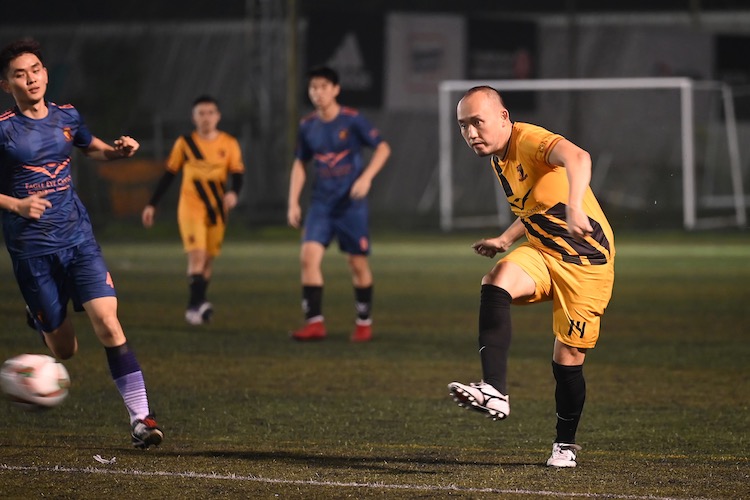
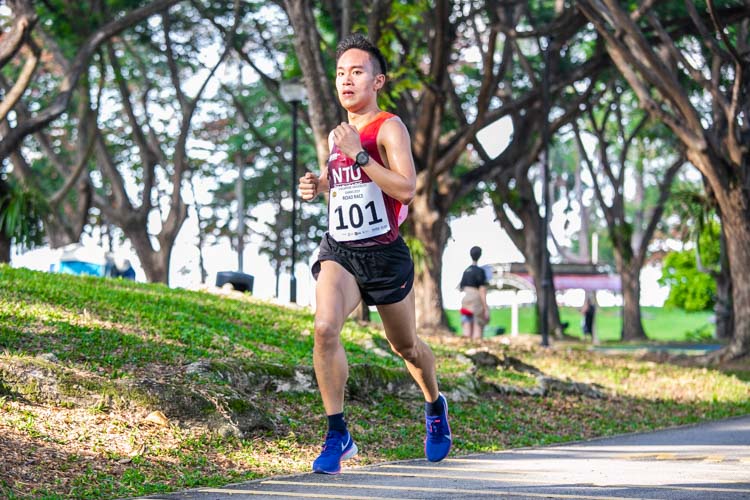
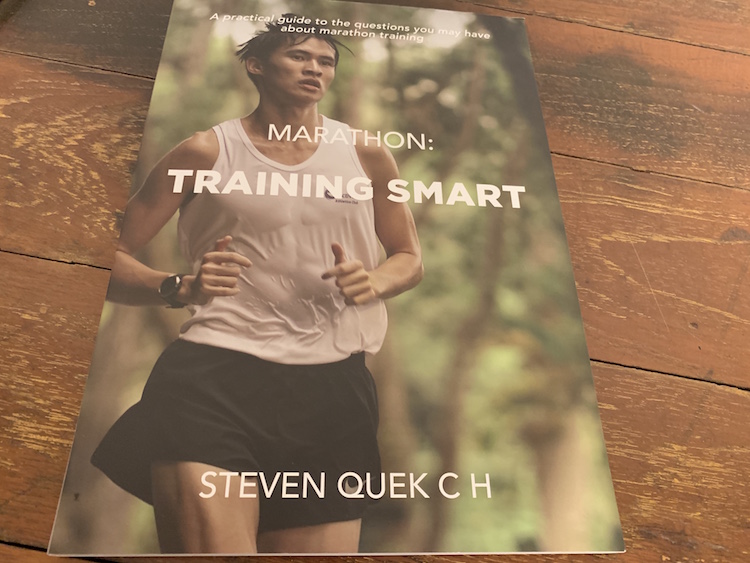
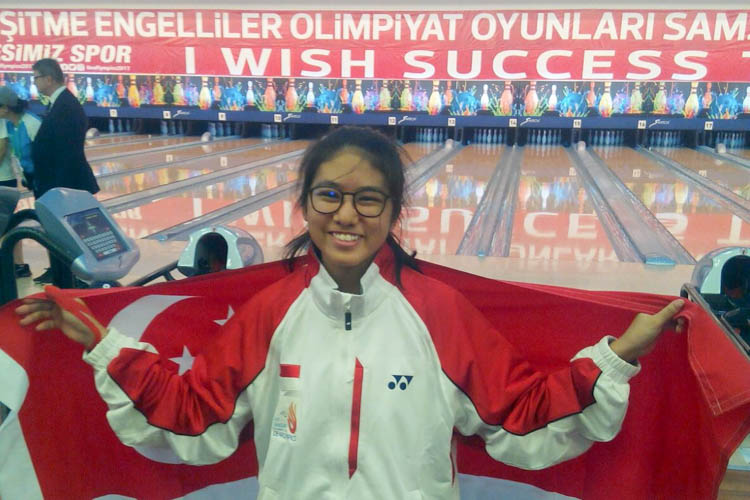
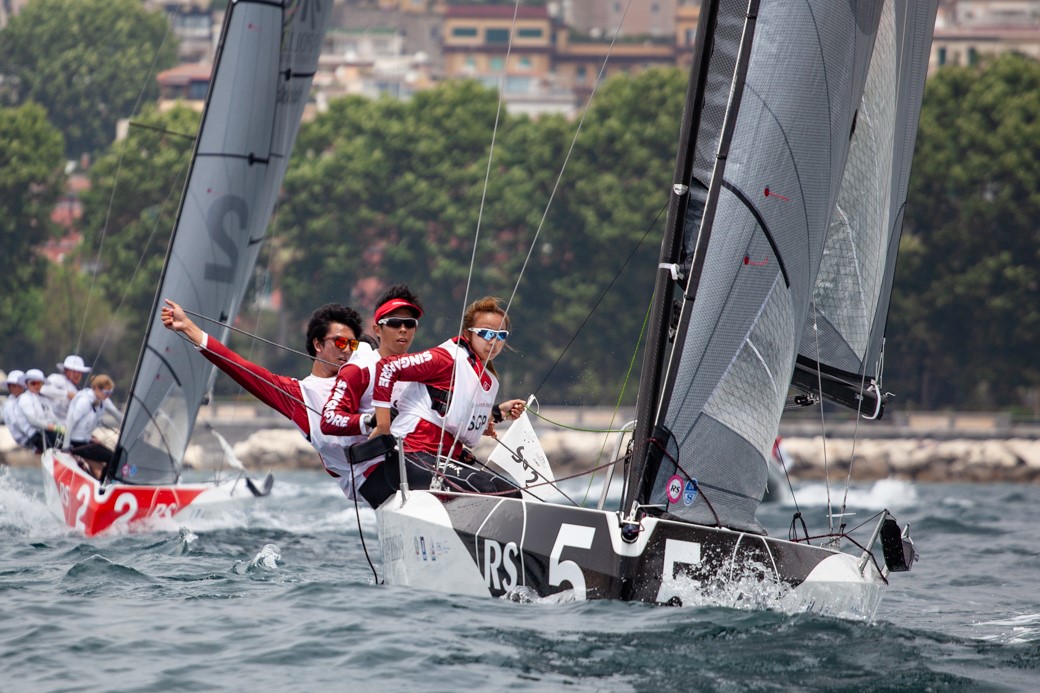
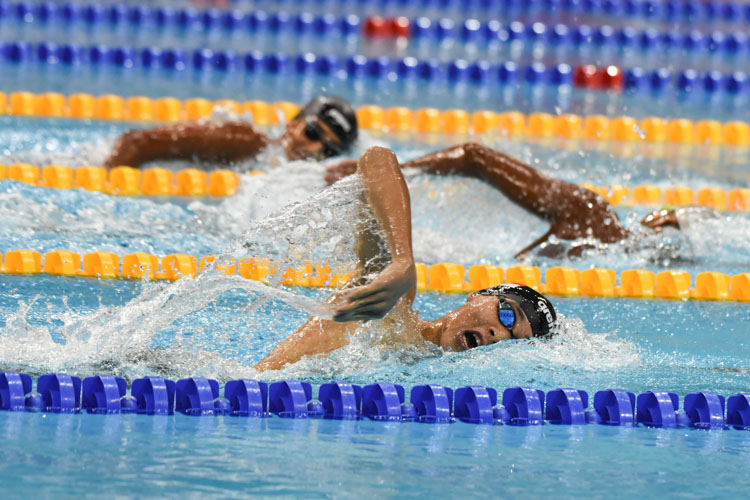
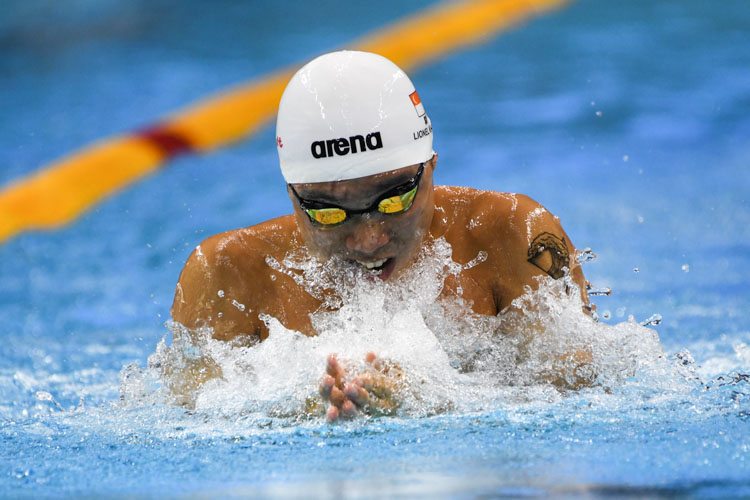
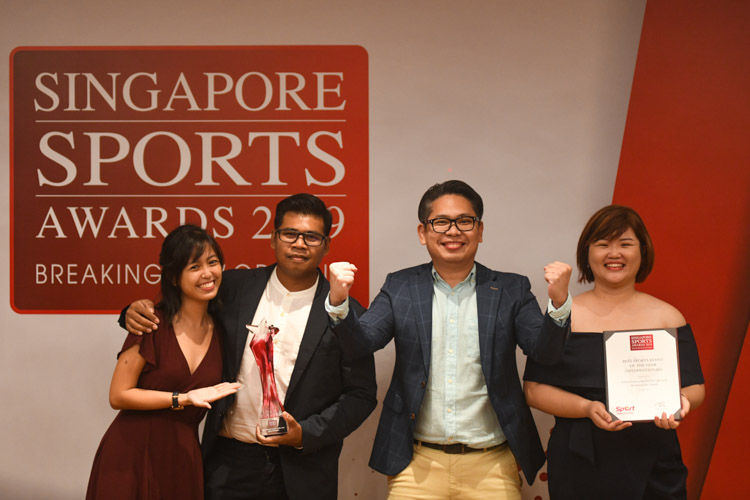
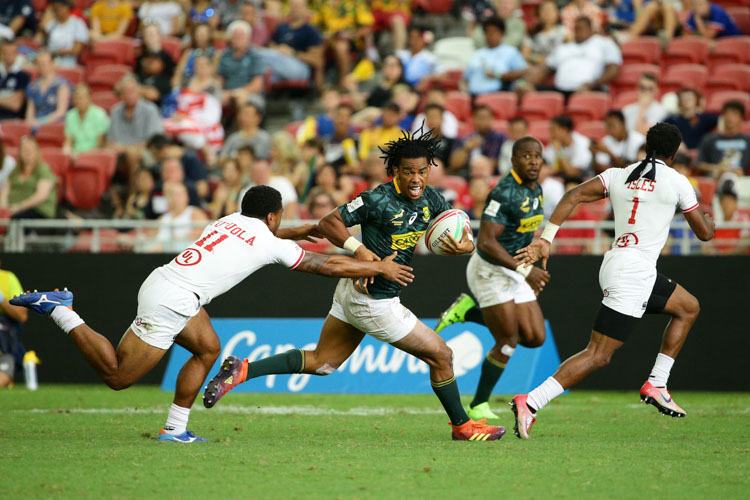
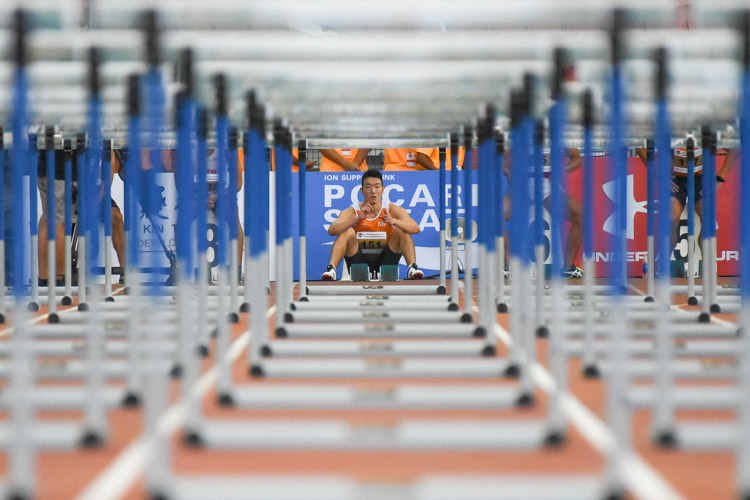
Leave A Comment